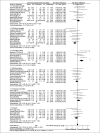Effects of unilateral vs. bilateral resistance training interventions on measures of strength, jump, linear and change of direction speed: a systematic review and meta-analysis
- PMID: 35959319
- PMCID: PMC9331349
- DOI: 10.5114/biolsport.2022.107024
Effects of unilateral vs. bilateral resistance training interventions on measures of strength, jump, linear and change of direction speed: a systematic review and meta-analysis
Abstract
Exercises can be categorized into either unilateral or bilateral movements. Despite the topic popularity, the answer to the question as to which (unilateral or bilateral) is superior for a certain athletic performance enhancement remains unclear. To compare the effect of unilateral and bilateral resistance training interventions on measures of athletic performance. Keywords related with unilateral, bilateral and performance were used to search in the Web of Science, PubMed databases, and Google Scholar and ResearchGate™ websites. 6365 articles were initially identified, 14 met the inclusion criteria and were included in the final analysis, with overall article quality being deemed moderate. The quantitative analysis comprised 392 subjects (aged: 16 to 26 years). Sub-group analysis showed that unilateral exercise resistance training resulted in a large effect in improving unilateral jump performance compared to bilateral training (ES = 0.89 [0.52, 1.26]). In contrast, bilateral exercise resistance training showed a small effect in improving bilateral strength compared to unilateral (ES = -0.43 [-0.71, -0.14]). Non-significant differences were found in improving unilateral strength (ES = 0.26 [-0.03, 0.55]), bilateral jump performance (ES = -0.04 [-0.31, 0.23]), change of direction (COD) (ES = 0.31 [-0.01, 0.63]) and speed (ES = -0.12 [-0.46, 0.21]) performance. Unilateral resistance training exercises should be chosen for improving unilateral jumping performance, and bilateral resistance training exercises should be chosen for improving bilateral strength performance.
Keywords: Bilateral exercises; Exercise selection; Performance; Unilateral exercises.
Copyright © Biology of Sport 2022.
Conflict of interest statement
The authors declare that they have no competing interests.
Figures


Similar articles
-
Effect of unilateral training and bilateral training on physical performance: A meta-analysis.Front Physiol. 2023 Apr 13;14:1128250. doi: 10.3389/fphys.2023.1128250. eCollection 2023. Front Physiol. 2023. PMID: 37123275 Free PMC article. Review.
-
Effect of unilateral and bilateral plyometric training on jumping, sprinting, and change of direction abilities: a meta-analysis.BMC Sports Sci Med Rehabil. 2025 Apr 25;17(1):97. doi: 10.1186/s13102-025-01113-6. BMC Sports Sci Med Rehabil. 2025. PMID: 40281589 Free PMC article.
-
Unilateral and Bilateral Lower-Body Resistance Training Does not Transfer Equally to Sprint and Change of Direction Performance.J Strength Cond Res. 2020 Jan;34(1):54-64. doi: 10.1519/JSC.0000000000003035. J Strength Cond Res. 2020. PMID: 30844983 Clinical Trial.
-
How to Improve Change-of-Direction Speed in Junior Team Sport Athletes-Horizontal, Vertical, Maximal, or Explosive Strength Training?J Strength Cond Res. 2020 Feb;34(2):473-482. doi: 10.1519/JSC.0000000000002814. J Strength Cond Res. 2020. PMID: 30199451 Clinical Trial.
-
Understanding change of direction ability in sport: a review of resistance training studies.Sports Med. 2008;38(12):1045-63. doi: 10.2165/00007256-200838120-00007. Sports Med. 2008. PMID: 19026020 Review.
Cited by
-
A Comparison of Bilateral vs. Unilateral Flywheel Strength Training on Physical Performance in Youth Male Basketball Players.J Funct Morphol Kinesiol. 2025 Feb 27;10(1):81. doi: 10.3390/jfmk10010081. J Funct Morphol Kinesiol. 2025. PMID: 40137333 Free PMC article.
-
The Influence of Step Load Periodisation Based on Time Under Tension in Hypoxic Conditions on Hormone Concentrations and Postoperative ACL Rehabilitation of a Judo Athlete: A Case Study.J Clin Med. 2025 Apr 8;14(8):2549. doi: 10.3390/jcm14082549. J Clin Med. 2025. PMID: 40283380 Free PMC article.
-
Effects of different external cooling placements prior to and during exercise on athletic performance in the heat: A systematic review and meta-analysis.Front Physiol. 2023 Jan 10;13:1091228. doi: 10.3389/fphys.2022.1091228. eCollection 2022. Front Physiol. 2023. PMID: 36703929 Free PMC article.
-
Repetition velocity as a measure of loading intensity in the free weight and Smith machine Bulgarian split squat.PeerJ. 2023 Aug 15;11:e15863. doi: 10.7717/peerj.15863. eCollection 2023. PeerJ. 2023. PMID: 37601249 Free PMC article.
-
Resistance band training with functional electrical stimulation improves force control capabilities in older adults: a preliminary study.EXCLI J. 2024 Jan 26;23:130-142. doi: 10.17179/excli2023-6777. eCollection 2024. EXCLI J. 2024. PMID: 38487085 Free PMC article.
References
-
- McGuigan, M.R., G.A. Wright, and S.J. Fleck. Strength training for athletes: does it really help sports performance? Int J Sports Physiol Perform, 2012. 7(1): 2–5. - PubMed
-
- Suchomel, T.J., S. Nimphius, and M.H. Stone. The importance of muscular strength in athletic performance. Sports Med, 2016. 46(10): 1419–1449. - PubMed
-
- Kraemer WJ, Ratamess NA, Flanagan SD, Shurley JP, Todd JS, Todd TC. Understanding the science of resistance training: an evolutionary perspective. Sports Med, 2017. 47(12): 2415–2435. - PubMed
-
- Siff, M. and YJ. Verkhoshansky, Super training: Strength training for sporting excellence. 1998, Denver, CO: Pittsburgh: Sports Support Syndicate.
-
- Young, WB. Transfer of strength and power training to sports performance. International journal of sports physiology and performance, 2006. 1(2): 74–83. - PubMed
Publication types
LinkOut - more resources
Full Text Sources
Miscellaneous
